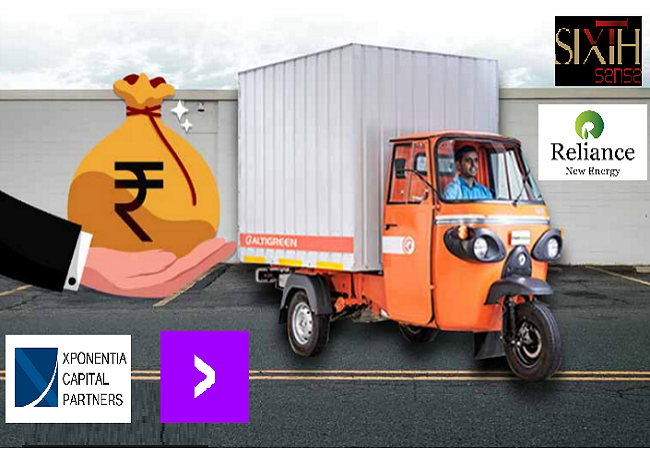How did Altigreen get investors such as Sixth Sense, Exponentia, Reliance New Energy, Accenture from the USA, and Momentum from Singapore, on board? What has changed since these came on board? Amitabh Saran, CEO & Co Founder, Altigreen answers
Q: Altigreen has an impressive bouquet of investors; please share the secret sauce behind the same!

A: The investor challenge has persisted in the EV and broader manufacturing sectors. Unlike the software realm, where a mere idea or prototype can attract investment, manufacturing demands a more substantial track record to attract investors. They seek evidence of sustained value creation due to manufacturing ventures’ higher capital intensity and associated risks.
Securing top-tier investors is a gradual process. They are looking for teams with the potential to make a significant impact. The varied investment landscape includes venture capitalists, growth-stage VCs, and private equity funds. It’s crucial to align with investors whose profiles resonate with your company’s trajectory and with whom you can effectively engage.
As for the future trajectory of these partnerships, it remains to be seen. The relationships with investors are not static; they evolve. The company and the investors continuously assess the potential benefits of increasing their stakes. These decisions are part of an ongoing dialogue shaped by mutual goals and visions. Ultimately, time will reveal the path these collaborations will take.
Q: How has Altigreen’s daily operations and overall business climate evolved from before the investors came on board compared to the current state after their involvement?
A: We have, over nine years up to February 2022, successfully raised between six and a half to seven million dollars. Despite EVs being present in India for many years, we were confronted with a pivotal question: Should we rely on imports, or could we manufacture these technologies domestically?
This was the landscape in 2011 and 2012 when the idea of indigenous technology production was virtually non-existent in India. Undeterred, we embarked on a mission to create these technologies in-house, including motors, controllers, DC harnesses, display clusters, software stacks, gearboxes, battery management systems, battery packs, and more.
Post-2020 marked a significant shift in our approach as we adopted an Original Equipment Manufacturer (OEM) mindset. The infusion of Series A funding was a catalyst for our expansion. It enabled us to set up an extensive production line, onboard dealers, and strengthen our software infrastructure with advanced systems like SAP.
In summary, our company’s evolution can be segmented into two distinct eras: the first nine years were dominated by research and development (R&D) and engineering, while the subsequent phase focused on business development, scaling, and addressing the evolving needs of our customers, including after-sales support and service.
Q: Altigreen started its journey by targeting to become a tier one supplier to OEMs, and even samples were sent out to a lot of electric vehicle OEMs. How difficult was this pivot to being an OEM?
A: Consider the staggering statistic that 93% of funded startups beyond the ideation phase fail globally. The lack of precedent compounds the difficulty; startups tread uncharted territory, doing what’s never been done, which necessitates constant learning and adaptation.
Initially, our role was to serve as a technology supplier to major Original Equipment Manufacturers (OEMs). However, our exact position in the supply chain, whether it was Tier 1 or Tier 2 was unclear. Research suggests that road transport contributes to 20-25% of these deaths. To put this in perspective, the tragic loss of one lakh people to COVID-19 prompted a national lockdown, yet the fatalities from pollution-related illnesses, conservatively four to five lakhs annually, persist without comparable action.
We recognised India’s need to foster self-reliance in this sector, advocating for the domestic production of components tailored to Indian conditions, a proposition we put forth to OEMs. Our beginnings as a retrofit company predate these discussions. Collaborating with OEMs, we discerned by 2018 that the shift from BS4 to BS6 standards monopolised their focus, relegating EVs to a mere research and development endeavour. This realisation led us to transition into becoming an OEM ourselves.
When it became evident that influencing the market through OEMs was not feasible, we shifted our focus to three-wheelers, a deliberate and strategic choice.
Q: How do you assess the current state of the electric vehicle component ecosystem in India, considering both your experience developing these components and the need to source from others?
A: We still manufacture all our components in-house. We produce our entire electric vehicle drivetrain and powertrain. However, we do collaborate with partners for non-core activities. For example, while the motor housing design is ours, we do not engage in foundry work for aluminium die casting. Instead, we partner with specialists and invest in their tooling to execute this.
Similarly, with gearboxes, we own the intellectual property for the micro-geometry of the gear teeth, but we outsource the actual manufacturing to a gear maker. While we are not gear manufacturers, we manage the final assembly and rigorous testing, as we are uncompromising on quality.
The component ecosystem has improved since we started in 2013, when only a few players existed. While there are still some grey areas to be addressed, there’s a growing recognition that India requires solutions tailored to its unique conditions, not just imported ones. The demand for high-quality engineering is increasing, and the ecosystem is responding positively.
Q: In rural India, or ‘Bharat’ as the Prime Minister refers to it, do you believe that the electric three-wheeler sector will see more growth in these areas compared to urban regions?
A: I respectfully disagree that our focus is solely on use cases prevalent in major cities, metros, or state capitals. Our decision to target the three-wheeler segment is strategic, as it affects a vast population—400 million people utilise three-wheelers daily. The imperative is to initiate change where it can have the most profound impact, and that’s exactly what we’re aiming for. Three-wheelers are a primary mode of transportation across numerous states, cities, provinces, and districts, and notably, they are the largest diesel consumers. We can make a significant environmental difference by transitioning this segment to electric.
There’s an indisputable need for our electric three-wheelers in primarily semi-urban and semi-rural scenarios—whether these areas are labelled as tier 1 or tier 2. Our goal is to focus on the strengths of our use cases and continue to expand. The question isn’t whether our approach should be Bharat-centric or Modern India-centric; the reality is that our vehicles serve diverse needs, from e-commerce to agriculture.
Q: Is there an ample ecosystem in rural India to support EV adoption?
A: We acknowledge that while infrastructure may be lacking in some areas, we can target numerous regions with a reliable power supply. Although we don’t expect an overnight shift to 100% electric three-wheelers—though that is our hope and aspiration—we are setting an ambitious goal to achieve this by 2028-29. This is based on the increasing use of renewable energy sources and electricity supply improvements, with power ministers’ claims that 99% of India is electrified, a situation that is expected to improve further.
To persuade consumers today, we believe in direct comparison: putting our electric vehicle (EV) alongside a diesel one and letting consumers see the difference. By offering month-long trials, consumers can experience the benefits firsthand—such as ease of use without gear changes and quieter operation. We understand that beyond the product itself, we must support customers with financing solutions and consider their credit histories to facilitate their transition to EVs.
As a startup or a growing company, considering the whole ecosystem, not just the product, is imperative. Sales are ultimately about peace of mind; without it, even the finest motors, recognised by industry leaders like Tesla, won’t lead to growth. To ensure customer satisfaction and peace of mind, we must follow systematic processes, gather data, and continuously evaluate vehicle performance, potential risks, and downtime. It’s a comprehensive approach to ensure our vehicles provide the reliability and comfort consumers expect.
Q: Could you elaborate on the extent to which financing is a challenge for your company, particularly compared to competitors like Mahindra, Bajaj, and Piaggio?
A: I can tell you that financing is a huge problem, and I have to give credit to the larger OEMs. Commendably, major Original Equipment Manufacturers (OEMs) have navigated these waters before us, although they initially faced similar hurdles. Over time, stalwarts like Mahindra, Bajaj, and Tata have established their financing arms, giving them a strategic advantage in making financial decisions more effortlessly than external financiers would.
For startups such as ours, convincing the financial ecosystem of the viability and reliability of our vehicles is a formidable task. It’s a gradual process, demanding irrefutable proof of the vehicle’s quality and not a mere novelty. The three-wheeler segment has struggled with securing finance, often resorting to high-interest ad hoc solutions. In stark contrast to the more ‘luxurious’ two and four-wheelers, three-wheelers — integral to many people’s livelihoods — suffered from exorbitant interest rates, sometimes up to 28-32%.
We’ve recognised that change is imperative. It’s not merely about accessing finance but securing it at sustainable interest rates. Our approach involves presenting our vehicles as dependable assets to financers, backed by real-time data on vehicle usage to mitigate payment risks. We understand that financiers are averse to repossessing vehicles; they need reliable information to collaborate with clients and adapt payment structures if necessary.
Q: In a yes or a no, is finance the biggest challenge for Altigreen?
A: Yes, for Altigreen, financing is indeed pivotal. With a fully engineered vehicle prepared and a dealer network established, the focus now shifts to deployment. Both wholesale and retail financing emerge as crucial elements in this phase.
Q: How are smaller players contributing to adopting electric vehicles (EVs) in rural India through financing?
A: Every player, whether small or large, is vital in the electric vehicle (EV) industry. Younger companies often can take more significant risks and act more aggressively, stimulating the entire sector. Their willingness to innovate has a catalytic effect, encouraging others to adopt new ways of thinking.
There’s no question that these risk-taking companies, especially new fintech firms, are introducing novel business models. For instance, we now see vehicles and batteries being financed separately, with some components available for rent while others are leased. These innovative approaches were unheard of, but they’ve materialised because startups dared to take risks, unleashing creativity and the willingness to experiment with new models.
These ventures are the harbingers of new products and service packages, drawing the attention of established companies. Their extensive data and fresh business models make young companies increasingly appealing to larger entities. This dynamic will likely drive rapid growth in the sector, and there’s no doubt such evolution is imminent.
Q: What’s your perspective on the trajectory of alternative fuel technologies in India?
A: It’s not going to be one size fits all. It doesn’t happen in a democracy and will not happen in the EV ecosystem. The approach towards adopting alternative fuels in the electric vehicle (EV) ecosystem will inevitably be diverse. No solution will fit every context—different regions may find certain fuels like CNG, biodiesel, or hydrogen more accessible depending on local availability and specific applications.
It’s likely that we’ll see a heterogeneous ecosystem where different technologies cater to distinct segments and types of vehicles. In commercial transport, the transition to alternative fuels is expected to accelerate quickly. On the other hand, the shift in personal passenger vehicles might be more gradual, transitioning through hybrid models that utilise both combustion and alternative fuels, given the existing infrastructure of combustion engines and the interests of original equipment manufacturers (OEMs) to remain relevant. Thus, while the adoption of EVs for personal use may take longer, the switch from commercial vehicles to alternative fuels is on a much faster track.
Based on Episode 1 of MOVES Ecosystem Dialogues

























